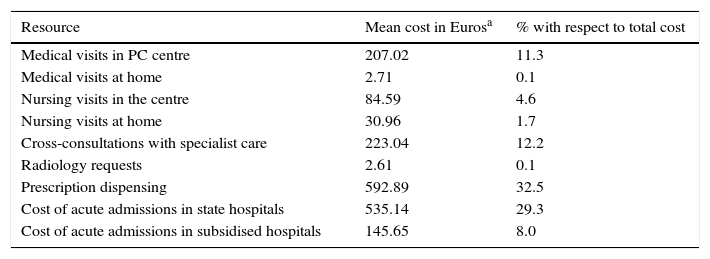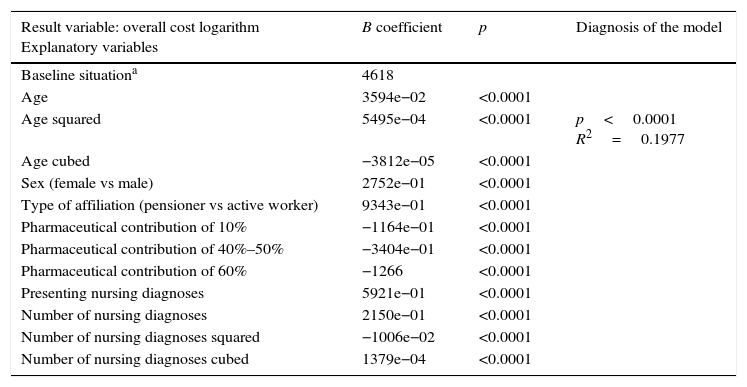The health service invests up to 75% of its resources on chronic care where the focus should be on caring rather than curing. Nursing staff focuses their work on such care. Care requires being redorded in health histories through the standardised languages. These records enable useful analyses to organisational and healthcare decision-making. Our proposal is to know the association of between nursing diagnosis and a higher total expenditure on health.
MethodAn observational cross-sectional analytical study was performed based on data from electronic health records in Primary Care (Drago-AP), hospital discharges (CMBD-AH) and prescriptions (REC-SCS) of patients over 50 from 2012 to 2013 in the Canary Islands. A descriptive, bivariate and multivariate analysis was undertaken to create a predictive model on the use of resources. Independent variables: Sociodemographic (age, sex, type of health-care affiliation, type of prescription charge) and nursing diagnosis (ND) recorded in late 2012. Dependent variables: resources consumed in 2013.
Results582,171 patients met the criteria for inclusion. 53.0% of them were women with an average age of 64.3 years (SD 10.8 years). 53.2% were pensioners. 49% of the included population had an ND, with an average of 2.1 ND per patient. The average costs per patient were 1824.62€ (with a median of 827.5€) 25 and 27 percentiles of 264.1€ and 1824.7€, respectively. The bivariate analysis showed a significant correlation between these expenses and all the demographic variables; the expenses increased when a nursing diagnosis has been made (Spearman's rank=0.37: the more diagnoses, the more expenses). In the multivariate analysis, a first linear regression with the sociodemographic variables as independent variables explains 13.7% of the variability of the logarithm of the full costs (R2=0.137). If we add to this model the presence of nursing diagnoses, the explanatory capacity reaches 19.77% (R2=0.1977).
ConclusionCompared with a model that only consists of sociodemographic variables, nursing diagnoses can enhance the explanatory capacity of the use of healthcare resources.
El sistema sanitario está invirtiendo un 75% de sus recursos en la atención a pacientes crónicos, en los que el foco de asistencia debe ser el cuidado y no la curación. El personal de enfermería centra su trabajo en dicho cuidado. El cuidado requiere de un registro a través de los lenguajes estandarizados en las historias de salud. Estos registros permiten diversos análisis útiles para la toma de decisiones sanitarias y organizativas. Se propone conocer cómo los diagnósticos de enfermería se asocian a un mayor gasto sanitario total.
MétodoEstudio transversal observacional analítico basado en los datos de las historias de salud de atención primaria (Drago-AP), altas hospitalarias (CMBD-AH) y dispensaciones de recetas (REC-SCS) en pacientes mayores de 50años durante el periodo de 2012-2013 en la comunidad canaria. Se realiza análisis descriptivo, bivariante y multivariante para generar un modelo predictivo del uso de recursos. Variables independientes: Sociodemográficas (edad, sexo, tipo de afiliación, tipo de aportación farmacéutica) y diagnósticos de enfermería (DdE) existentes a finales de 2012. Variables dependientes: Recursos sanitarios consumidos durante el año 2013.
ResultadosUn total de 582.171 pacientes cumplían criterios de inclusión. Un 53,0% eran mujeres, y la edad media era de 64,3años (DE: 10,8años); un 53,2% eran pensionistas. El 49,3% de la población incluida tienen algún DdE, con una media de 2,1 DdE por paciente incluido. El coste medio anual por paciente fue de 1.824,62€, con una mediana de 827,5€ y unos percentiles 25 y 75 de 264,1 y 1.824,7€, respectivamente. En el análisis bivariante este gasto se correlacionó significativamente con todas las variables demográficas y aumentó en presencia de diagnósticos de enfermería de forma significativa (ρ de Spearman=0,37: a mayor número de diagnósticos, mayor gasto). En el análisis multivariante, un primer modelo de regresión lineal conformado por las variables sociodemográficas explica el 13,70% (R2=0,137) de la variabilidad del logaritmo de los costes totales. Si a ese modelo le añadimos la existencia y el número de diagnósticos de enfermería, llegamos a una capacidad explicativa del 19,77% (R2=0,1977).
ConclusiónComparado con un modelo que consta solo de variables sociodemográficas, los diagnósticos de enfermería pueden elevar la capacidad explicativa del uso de recursos sanitarios.












